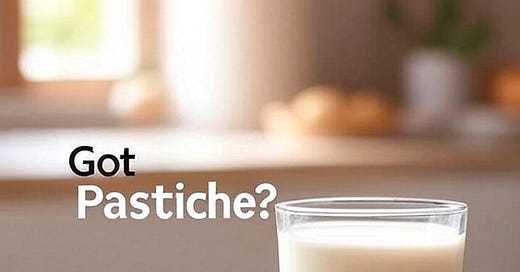Intellectual Property: What is Pastiche and Why do you Care in the age of AI?
HAPPY MONDAY BEEN AWAY BUILDING DIGITAL THINGS (AGAIN) MORE NEWS SOON
“Cyrus you do not ‘have to’ save the Law with AI. You ‘get to’ save the Law with AI!”
What is Pastiche in Intellectual Property Law?
CONGRATULATIONS AND LOOK AT THE IMAGE ABOVE, AI COUNSEL HAS JUST SHOWN YOU YOUR FIRST “PASTICHE”! YOU ARE WELCOME.
High Topicality to AI, on the Cutting Edge of Intellectual Jurisprudence : READ [THIS IS NOT PARODY, ROFL, PASTICHE IS NOT PARODY!]
In intellectual property (IP) law, a pastiche refers to a creative work that imitates, mimics, or combines elements of existing works, often as a form of homage, parody, or stylistic tribute.
It is recognized in some jurisdictions as an exception to copyright infringement, allowing limited use of copyrighted material without permission, provided it meets specific criteria.
In the UK, the concept of pastiche is codified under Section 30A of the Copyright, Designs and Patents Act 1988 (CDPA), introduced via the EU Copyright Directive (2001/29/EC).
This section permits the use of copyrighted works for "caricature, parody, or pastiche" to the extent that such use is deemed "fair dealing."
Unlike parody, which often involves humor or critique, pastiche typically involves stylistic imitation or blending without necessarily mocking the original work.
The pastiche exception is narrowly defined and requires a balance between the rights of the copyright holder and the freedom of expression of the creator.
WHAT I HAVE ALWAYS TOLD YOU PLEASE REMEMBER, IN COPYRIGHT THERE ARE TWO “WINGS”
PROTECTION OF CREATIVE WORKS
AND
PROTECTION OF THE ADVANCEMENT OF NEW CREATIVE WORKS.
Courts assess whether the use is "fair" by considering factors such as the extent of the copying, the purpose of the use, and the potential harm to the original work’s market value.
In the context of generative AI, the pastiche defense is increasingly relevant as AI models like Stable Diffusion produce outputs that may resemble or draw inspiration from existing copyrighted works.
Pastiche in the Getty Images v. Stability AI Case
In the ongoing Getty Images v. Stability AI case, [WHERE GETTY ALLEGES STABILITY CRIBBED 12 MILLION OF ITS IMAGES AS TRAINING DATA] Stability AI has invoked the pastiche defense in the UK High Court to counter Getty’s claims of copyright infringement.
Getty alleges that Stability AI unlawfully used millions of its copyrighted images to train Stable Diffusion, a generative AI model that produces images from text prompts.
Some AI-generated outputs reportedly resemble Getty’s images or even bear Getty’s watermarks, prompting claims of direct and secondary infringement.
Stability AI argues that the outputs of Stable Diffusion qualify as pastiche under Section 30A of the CDPA. Specifically, they contend that the AI-generated images are creative imitations or transformations of existing styles, not direct reproductions of specific copyrighted works.
In their defense, Stability AI asserts that these outputs are akin to a pastiche because they blend influences from a vast dataset (including Getty’s images) to create novel works, similar to how an artist might draw inspiration from multiple sources.
They further argue that users, not the AI itself, control the prompts, and thus any similarity to copyrighted works is incidental and falls within the fair dealing exception for pastiche.
Stability AI’s defense includes the following argument:
“The images generated by Stable Diffusion constitute a pastiche within the meaning of Section 30A of the CDPA, as they are transformative works that draw on a broad range of visual influences to create new artistic expressions, rather than direct copies of any specific work in the training dataset. The use of such works falls within the fair dealing exception, as it does not compete with or harm the market for the original copyrighted images.”
This defense hinges on the interpretation of “pastiche” as a broad, transformative act of creation, distinct from verbatim copying.
Stability AI also emphasizes that the training process involves abstract patterns and features, not wholesale reproduction, further supporting their claim that any output resembling Getty’s images is a pastiche rather than an infringing copy.
THE PASTICHE DEFENSE IS BRAND NEW IN AI LITIGATION AND IS UNTESTED in the context of generative AI, making Getty Images v. Stability AI a potential landmark case.
The UK court, in its trial scheduled for TODAY June 9–30, 2025, will need to determine whether AI-generated outputs can qualify as pastiche and whether the training process itself respects fair dealing principles.
A ruling in favor of Stability AI could expand the scope of the pastiche exception, potentially allowing AI developers broader leeway to use copyrighted material in training datasets.
Conversely, a ruling for Getty could narrow the exception, imposing stricter licensing requirements on AI developers.
BE SMARTER THAN YOUR FRIENDS.
TELL THEM YOU KNOW ABOUT PASTICHE.
TELL THEM THAT AI COUNSEL DONE TOLD YOU.
BE THE FIRST TO USE THIS “BUZZWORD” WHICH WILL TAKE OVER TIMELINES ON X BY ABOUT THIS THURSDAY I PREDICT, AI COUNSEL ALWAYS BEING DAYS OR WEEKS AHEAD OF POPULAR THINKING……………………………………………………..
“Peace and Pastiche”
-Cyrus
PS - SHOOT FAMS, EVEN THE LOGO IS A LITTLE SUS……………………………………..






